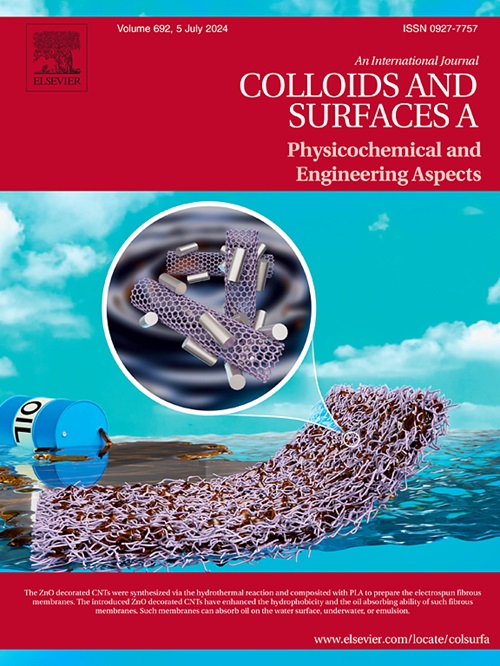Self-pumping hierarchical porous sponge with fluid management and antimicrobial properties for enhancing wound healing
IF 4.9
2区 化学
Q2 CHEMISTRY, PHYSICAL
Colloids and Surfaces A: Physicochemical and Engineering Aspects
Pub Date : 2025-07-10
DOI:10.1016/j.colsurfa.2025.137716
引用次数: 0
Abstract
Conventional dressings are ineffective in preventing bacterial infections and exudate, thereby hindering wound healing. In this study, a Janus self-pumping dressing with antimicrobial activity was designed that can discharge excess exudate unidirectionally, effectively promoting wound healing and avoiding bacterial infection. The Janus self-pumping sponge dressings rely on its asymmetric wettability and hierarchical pore microstructure to provide capillary force, pumping excess exudate from the hydrophobic side to the hydrophilic side to prevent exudate reflux and rewetting the wound. The antibacterial nanoparticles loaded during the formation of hydrophobic surfaces can prevent bacterial infection, thereby promoting wound healing more effectively than traditional dressings. The dressing exhibited sustained antibacterial efficacy (>95 % inhibition against bacteria within 48 h), significantly mitigating wound infection risks. In murine full-thickness wound models, compared with sterile gauze group, the Janus self-pumping dressing achieved rapid exudate management and antibacterial performance, thereby accelerating wound healing. Therefore, this self-pumping dressing with unique fluid management capability has great potential to become the next generation of clinical wound healing dressings.
自泵分层多孔海绵与流体管理和抗菌性能,促进伤口愈合
传统敷料不能有效防止细菌感染和渗出,从而阻碍伤口愈合。本研究设计了一种具有抗菌活性的Janus自泵敷料,可单向排出多余渗出物,有效促进创面愈合,避免细菌感染。Janus自抽吸海绵敷料依靠其不对称润湿性和分层孔隙微观结构提供毛细力,将多余的渗出液从疏水侧抽到亲水侧,以防止渗出液回流和重新润湿伤口。在疏水表面形成过程中负载的抗菌纳米颗粒可以防止细菌感染,从而比传统敷料更有效地促进伤口愈合。该敷料表现出持续的抗菌效果(48 h内对细菌的抑制率>; 95% %),显著降低了伤口感染风险。在小鼠全层创面模型中,与无菌纱布组相比,Janus自泵敷料实现了快速的渗出管理和抗菌性能,从而加速创面愈合。因此,这种具有独特流体管理能力的自抽吸敷料具有成为下一代临床伤口愈合敷料的巨大潜力。
本文章由计算机程序翻译,如有差异,请以英文原文为准。
求助全文
约1分钟内获得全文
求助全文
来源期刊
CiteScore
8.70
自引率
9.60%
发文量
2421
审稿时长
56 days
期刊介绍:
Colloids and Surfaces A: Physicochemical and Engineering Aspects is an international journal devoted to the science underlying applications of colloids and interfacial phenomena.
The journal aims at publishing high quality research papers featuring new materials or new insights into the role of colloid and interface science in (for example) food, energy, minerals processing, pharmaceuticals or the environment.

 求助内容:
求助内容: 应助结果提醒方式:
应助结果提醒方式:


